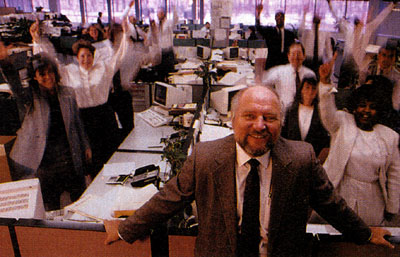
Benefits For The Back Office, Too
Business Week - July 10, 1989 - By John Hoerr
ATTCC's Wajnert: Using managers mostly for advice, not consent. It's not only Rust Belt America that needs to overhaul tlie way work is organized. Millions of clerical employees toil in the back offices of financial companies, processing applications, claims, and customer accounts on what amount to electronic assembly lines. The jobs are dull and repetitive and efficiency gains minuscule_when they come at all.
That was the case with AT&T Credit Corp. (ATTCC) when it opened shop in 1985 as a newly created subsidiary of American Telephone & Telegraph Co. Based in Morristown, N. J., ATTCC provides financing for customers who lease equipment from AT&T and other companies. A bank initially retained by ATTCC to pro cess lease applications couldn't keep up with the volume of new business.
ATTCC President Thomas C. WaJnert saw that the fault lay in the bank's method of dividing labor~ into narrow tasks and organizing work by function. One department handled applications and checked the customer's credit standing, a second drew up contracts, and a third collected payments. So no one person or group had responsibility for providing full service to a customer. "The employees had no sense of how their jobs contributed to the final solution for the customer," Wajuert says.
Unexpected Bonus
Wajuert decided to hire his own employees and give them "ownership and accountability." His first concern was to increase efficiency, not to provide more rewarding jobs. But in the end, he did both.
In 1986, ATTCC set up 11 teams of 10 to 15 newly hired workers in a highvolume division serving small businesses. The three major lease-processing functions were combined in each team. No longer were calls from customers shunted from department to department. The company also divided its national staff of field agents into seven regions and assigned two or three teams to handle business from each region. That way, the same teams always worked with the same sales staff, establishing a personal relationship with them and their customers. Above all, team members took responsibility for solving customers' problems. ATTCC'S new slogan: "Whoever gets the call owns the problem."
The teams largely manage themselves. Members make most decisions on how to deal with customers, schedule their own time off, reassign work when people are absent, and interview prospective new employees. The only supervisors are seven regional managers who advise the team members, rather than give orders. The result: The teams process up to 800 lease applications a day vs. 400 under the old system. Instead of taking several days to give a f~nal yes or no, the teams do it in 24 to 48 hours. As a result, ATTGC is growing at a 40%-to-50% compound annual rate, Wajnert says.
Extra Cash
The teams also have economic incentives for providing good service. A bonus plan tied to each team's costs and profits can produce extra cash. The employees, most of whom are young college graduates, can add $1,500 a year to average salaries of $28,000, and pay rises as employees learn new skills. "It's a phenomenal learning opportunity," says 24-year-old team member Michael LoCastro.
But LoCastro and others complain that promotions are rare because there are few managerial positions. And everyone comes under intense pressure from co-workers to produce more. The annual turnover rate is high: Some 20% of ATTCC employees either quit or transfer to other parts of AT&T. Still, the team experiment has been so successful that ATTCC iS involving employees in planning to extend the concept throughout the company. "They will probably come up with as good an organizational design as management could," Wajnert says, "and it will work a lot better because the employees will take ownership for it."

